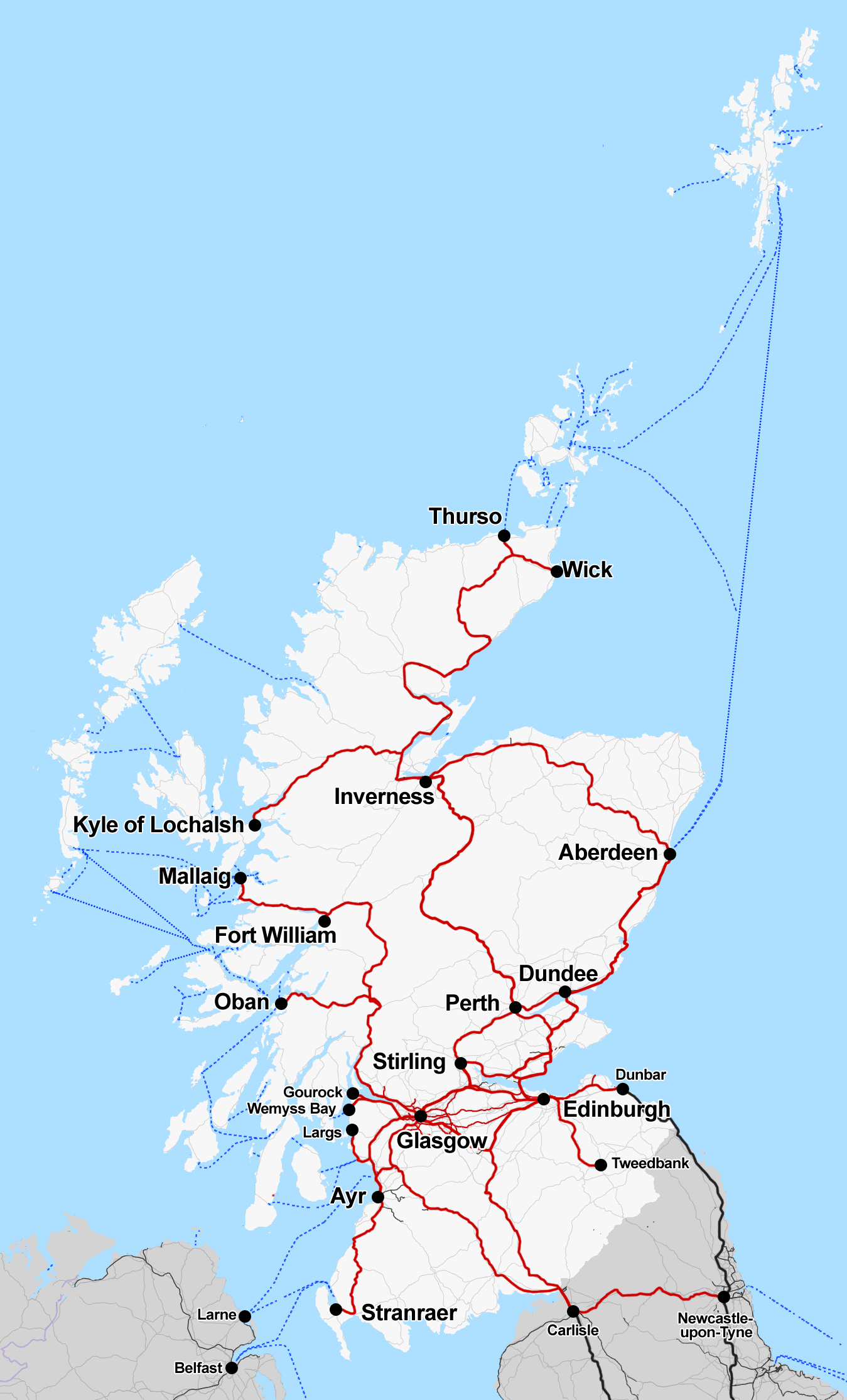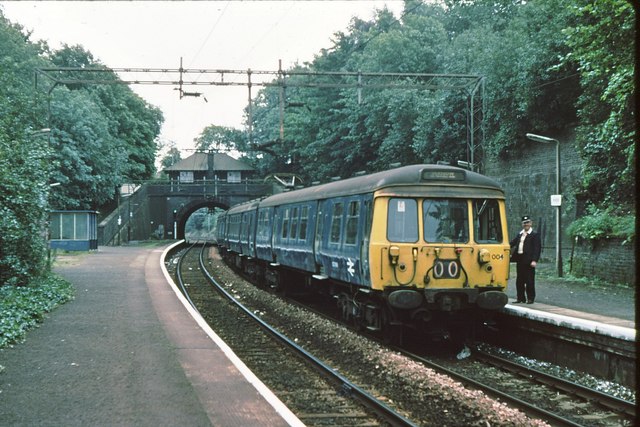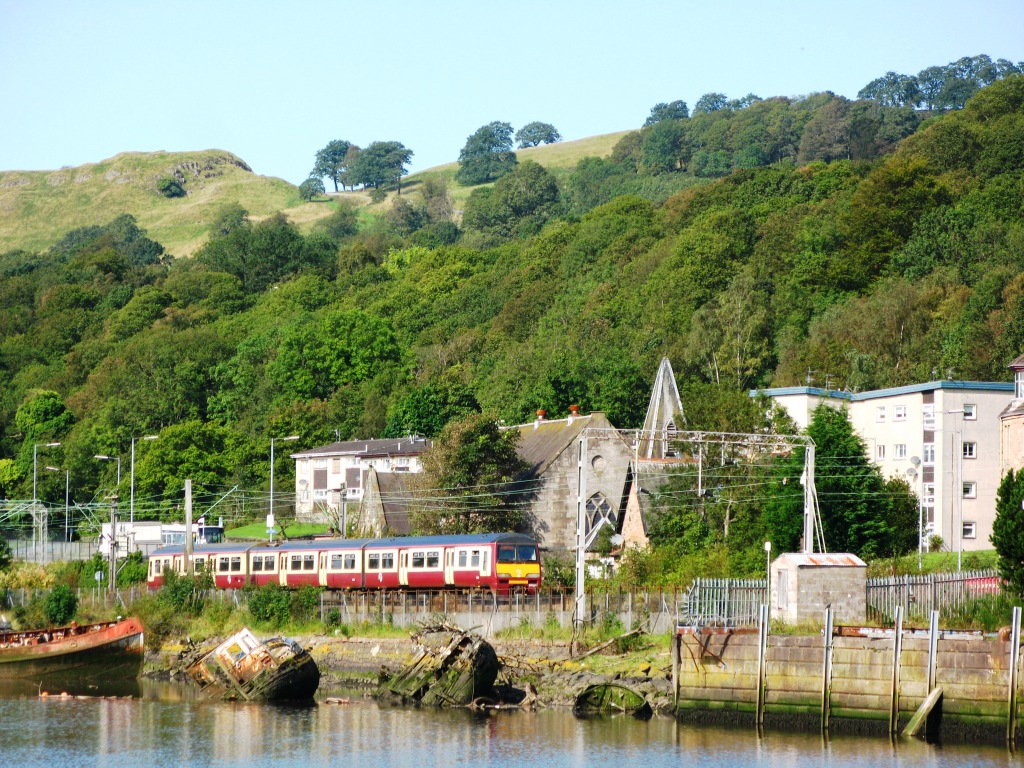|
British Rail Class 320
The British Rail Class 320 is an electric multiple unit (EMU) passenger train found on the Strathclyde rail network in Central Scotland. They are mainly used on the North Clyde Line and the Argyle Line, but they can also be seen on Glasgow Central to Lanark and Cathcart Circle and Inverclyde Line services. The Class 320 uses alternating current (AC) overhead electrification. Details The Class 320 is effectively a three-car derivative of the Class 321 units found in and around London, East Anglia and Yorkshire. Built in 1990 by British Rail Engineering Limited's Holgate Road carriage works, 22 three-car sets were ordered by SPT to replace the Class 303 and Class 311, which were by then 30 years old. The trains were built against order numbers 31060–31062, which were issued on 6 January 1989 and completed on 31 October 1990. The units run on 25 kV AC overhead line supply via a Brecknell Willis high speed pantograph, using four Brush TM2141B traction motors. With much sh ... [...More Info...] [...Related Items...] OR: [Wikipedia] [Google] [Baidu] |
Abellio ScotRail
Abellio ScotRail, operating services under the name ScotRail, was the national train operating company of Scotland. A subsidiary of Abellio, it operated the ScotRail franchise from 1 April 2015, taking over from predecessor First ScotRail. The franchise ended on 31 March 2022 and was replaced by ScotRail, an operator of last resort owned by the Scottish Government. History In November 2013, Transport Scotland announced that Abellio, Arriva, FirstGroup, MTR Corporation and National Express had been shortlisted to bid for the new ScotRail franchise. In October 2014, the franchise was awarded to Abellio."Abellio awarded ScotRail franchise" '' [...More Info...] [...Related Items...] OR: [Wikipedia] [Google] [Baidu] |
Railway Disc Brake
A disc brake is a type of brake that uses the calipers to squeeze pairs of pads against a disc or a "rotor" to create friction. This action slows the rotation of a shaft, such as a vehicle axle, either to reduce its rotational speed or to hold it stationary. The energy of motion is converted into waste heat which must be dispersed. Hydraulically actuated disc brakes are the most commonly used form of brake for motor vehicles, but the principles of a disc brake are applicable to almost any rotating shaft. The components include the disc, master cylinder, and caliper (which contains a cylinder and two brake pads) on both sides of the disc. Design The development of disc-type brakes began in England in the 1890s. In 1902, the Lanchester Motor Company designed brakes that looked and operated in a similar way to a modern disc-brake system even though the disc was thin and a cable activated the brake pad. Other designs were not practical or widely available in cars for another 6 ... [...More Info...] [...Related Items...] OR: [Wikipedia] [Google] [Baidu] |
Yorkshire
Yorkshire ( ; abbreviated Yorks), formally known as the County of York, is a Historic counties of England, historic county in northern England and by far the largest in the United Kingdom. Because of its large area in comparison with other English counties, functions have been undertaken over time by its subdivisions, which have also been subject to History of local government in Yorkshire, periodic reform. Throughout these changes, Yorkshire has continued to be recognised as a geographic territory and cultural region. The name is familiar and well understood across the United Kingdom and is in common use in the media and the Yorkshire Regiment, military, and also features in the titles of current areas of civil administration such as North Yorkshire, South Yorkshire, West Yorkshire and the East Riding of Yorkshire. Within the borders of the historic county of Yorkshire are large stretches of countryside, including the Yorkshire Dales, North York Moors and Peak District nationa ... [...More Info...] [...Related Items...] OR: [Wikipedia] [Google] [Baidu] |
Alternating Current
Alternating current (AC) is an electric current which periodically reverses direction and changes its magnitude continuously with time in contrast to direct current (DC) which flows only in one direction. Alternating current is the form in which electric power is delivered to businesses and residences, and it is the form of electrical energy that consumers typically use when they plug kitchen appliances, televisions, fans and electric lamps into a wall socket. A common source of DC power is a battery cell in a flashlight. The abbreviations ''AC'' and ''DC'' are often used to mean simply ''alternating'' and ''direct'', as when they modify ''current'' or ''voltage''. The usual waveform of alternating current in most electric power circuits is a sine wave, whose positive half-period corresponds with positive direction of the current and vice versa. In certain applications, like guitar amplifiers, different waveforms are used, such as triangular waves or square waves. Audio a ... [...More Info...] [...Related Items...] OR: [Wikipedia] [Google] [Baidu] |
Cathcart Circle Lines
The Cathcart Circle Lines form a mostly suburban railway route linking Glasgow (Central) to Cathcart via a circular line, with branches to Newton and Neilston, on the south bank of the River Clyde. They are part of the Strathclyde Partnership for Transport network. History The lines were built by the Cathcart District Railway (Cathcart Circle) and the Lanarkshire and Ayrshire Railway (Newton and Neilston lines). The first part opened on 1 March 1886 as a double line from Glasgow Central to then single to Cathcart, doubled on 26 May 1886. The circular route back to Central station via Shawlands and Maxwell Park was completed on 2 April 1894. The Newton and Neilston branches were built to provide a through route from the Lanarkshire coalfields to ports such as Ardrossan on the Ayrshire coast. There is still a junction with other lines at Newton, but the track beyond Neilston has been lifted. The lines originally carried significant amounts of freight, but commuter trains ... [...More Info...] [...Related Items...] OR: [Wikipedia] [Google] [Baidu] |
Lanark
Lanark (; gd, Lannraig ; sco, Lanrik) is a town in South Lanarkshire, Scotland, located 20 kilometres to the south-east of Hamilton. The town lies on the River Clyde, at its confluence with Mouse Water. In 2016, the town had a population of 9,050. Lanark has been a royal burgh since 1140, and was historically the county town of Lanarkshire, though in modern times this title belongs to Hamilton. Notable landmarks nearby include New Lanark, the Corra Linn and the site of Lanark Castle. Lanark railway station and coach station have frequent services to Glasgow. There is little industry in Lanark and some residents commute to work in Glasgow and Edinburgh. Its shops serve the local agricultural community and surrounding villages. There is a large modern livestock auction market on the outskirts of the town. History The town's name is believed to come from the Cumbric ' meaning "clear space, glade". Lanark has served as an important market town since medieval times, and Kin ... [...More Info...] [...Related Items...] OR: [Wikipedia] [Google] [Baidu] |
Glasgow Central Station
, symbol_location = gb , symbol = rail , image = Main Concourse at Glasgow Central Station.JPG , caption = The main concourse , borough = Glasgow, City of Glasgow , country = Scotland , coordinates = , grid_name = Grid reference , grid_position = , manager = Network Rail , platforms = 17 (including 2 on lower level) , code = GLC , zone = G2 , transit_authority = SPT , years = 1 August 1879 , events = High Level Station openedButt (1995), page 103 , years1 = 10 August 1896 , events1 = Low Level Station opened , years2 = 1901–1905 , events2 = High Level Station rebuilt , years3 = 1960 , events3 = Re-signalling , years4 = 5 October 1964 , events4 = Closure of Low Level Station , years5 ... [...More Info...] [...Related Items...] OR: [Wikipedia] [Google] [Baidu] |
Argyle Line
The Argyle Line is a suburban railway located in West Central Scotland. The line serves the commercial and shopping districts of Glasgow's central area, and connects towns from West Dunbartonshire to South Lanarkshire. Named for Glasgow's Argyle Street, the line uses the earlier cut-and-cover tunnel running beneath that thoroughfare. The term "Argyle Line" is commonly used to describe: * the extensive urban passenger train service that connects the towns and suburbs of North Clyde with Motherwell, Larkhall, and Lanark, to the southeast. Of the 48 stations, 4 are in West Dunbartonshire, 4 in East Dunbartonshire, 17 in Glasgow City, 10 in North Lanarkshire, and 13 in South Lanarkshire. * the central portion of railway infrastructure encompassing less than . History Prior to 1964 The Glasgow Central Railway (GCR) under central Glasgow opened in 1886, connecting the Lanarkshire and Dunbartonshire Railway at and Stobcross Railway at to the Lanarkshire and Ayrshire Railway near , ... [...More Info...] [...Related Items...] OR: [Wikipedia] [Google] [Baidu] |
North Clyde Line
The North Clyde Line (defined by Network Rail as the ''Glasgow North Electric Suburban'' line) is a suburban railway in West Central Scotland. The route is operated by ScotRail Trains. As a result of the incorporation of the Airdrie–Bathgate rail link and the Edinburgh–Bathgate line, this route has become the fourth rail link between Glasgow and Edinburgh. Route The North Clyde Line (known as Dunbartonshire - Glasgow, Cumbernauld and Falkirk Grahamston in timetables), electrified by British Rail in 1960, ran east–west through the Greater Glasgow conurbation, linking northern Lanarkshire with western Dunbartonshire, by way of the city centre. Fifty years later, in 2010, the line was extended by Network Rail east from Airdrie, by way of re-opening the line to Bathgate meeting up with the line re-opened by British Rail from Edinburgh. The main core of the route runs from to via and Glasgow Queen Street (Low Level). To the east of the Glasgow city centre, there i ... [...More Info...] [...Related Items...] OR: [Wikipedia] [Google] [Baidu] |
Scotland
Scotland (, ) is a country that is part of the United Kingdom. Covering the northern third of the island of Great Britain, mainland Scotland has a border with England to the southeast and is otherwise surrounded by the Atlantic Ocean to the north and west, the North Sea to the northeast and east, and the Irish Sea to the south. It also contains more than 790 islands, principally in the archipelagos of the Hebrides and the Northern Isles. Most of the population, including the capital Edinburgh, is concentrated in the Central Belt—the plain between the Scottish Highlands and the Southern Uplands—in the Scottish Lowlands. Scotland is divided into 32 administrative subdivisions or local authorities, known as council areas. Glasgow City is the largest council area in terms of population, with Highland being the largest in terms of area. Limited self-governing power, covering matters such as education, social services and roads and transportation, is devolved from the Scott ... [...More Info...] [...Related Items...] OR: [Wikipedia] [Google] [Baidu] |
Strathclyde
Strathclyde ( in Gaelic, meaning "strath (valley) of the River Clyde") was one of nine former local government regions of Scotland created in 1975 by the Local Government (Scotland) Act 1973 and abolished in 1996 by the Local Government etc. (Scotland) Act 1994. The Strathclyde region had 19 districts. The region was named after the medieval Kingdom of Strathclyde but covered a broader geographic area than its namesake. Functions The area was on the west coast of Scotland and stretched from the Highlands in the north to the Southern Uplands in the south. As a local government region, its population, in excess of 2.5 million, was by far the largest of the regions and contained half of the nation's total. The Region was responsible for education (from nursery to colleges); social work; police; fire; sewage; strategic planning; roads; transport – and, therefore, employed almost 100,000 public servants (almost half were teachers, lecturers and others in the education ... [...More Info...] [...Related Items...] OR: [Wikipedia] [Google] [Baidu] |
Electric Multiple Unit
An electric multiple unit or EMU is a multiple-unit train consisting of self-propelled carriages using electricity as the motive power. An EMU requires no separate locomotive, as electric traction motors are incorporated within one or a number of the carriages. An EMU is usually formed of two or more semi-permanently coupled carriages, but electrically powered single-unit railcars are also generally classed as EMUs. The great majority of EMUs are passenger trains, but versions also exist for carrying mail. EMUs are popular on commuter and suburban rail networks around the world due to their fast acceleration and pollution-free operation. Being quieter than diesel multiple units (DMUs) and locomotive-hauled trains, EMUs can operate later at night and more frequently without disturbing nearby residents. In addition, tunnel design for EMU trains is simpler as no provision is needed for exhausting fumes, although retrofitting existing limited-clearance tunnels to accommodate the ... [...More Info...] [...Related Items...] OR: [Wikipedia] [Google] [Baidu] |





_Central_Station%2C_Glasgow.jpg)


